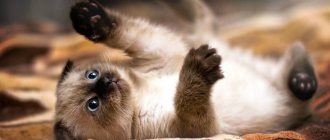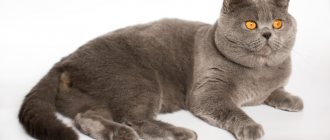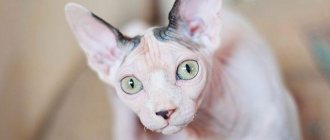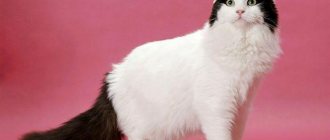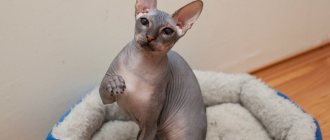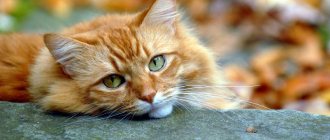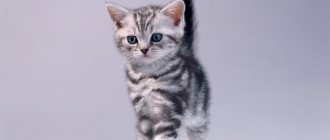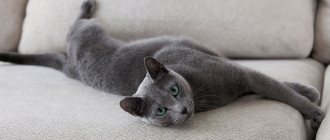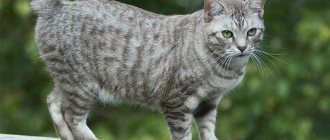History of the origin of the breed
The first mentions of Siberian cats in Russia date back to the 16th century. They were called Bukhara cats. This is connected with one of the versions of the origin of the breed, according to which the ancestors of the Siberian cat were brought beyond the Urals by traders from Asia.
Siberian cat
According to another, the ancestors of the breed were cats brought by settlers from the central part of Russia during the development of Siberia.
Animals, in the process of assimilation with wild, forest cats, adapted to the harsh climate with long winters, acquired an independent character, and the habits of hunters.
The breed standard was established in the late 80s of the 20th century. Within a few years, the animals participated in international exhibitions. The breed was recognized by felinological organizations in Western countries.
Interesting facts about the breed
- The cat of the Siberian breed Dorofey, who belonged to D.A., became famous. Medvedev. He was a participant in a popular television show.
- Siberian cats are considered the best rat catchers; not a single rodent can escape the clutches of a Siberian.
- The Siberian cat is naturally formed by nature and with all its huge appearance shows power and health.
- In Tyumen Park there is a “Square of Siberian Cats” in the form of 12 cast iron figures painted with golden paint. They were installed in honor of the cats who, during the Second World War, saved the collections of the Leningrad Hermitage from an invasion of rats.
Description and appearance of the Siberian cat
Animals of this breed are large, with well-developed muscles. The weight of males varies from 10 to 13 kg, females - from 5 to 7 kg.
The standard regulates the following characteristics of the breed:
- The body is stocky with a short powerful neck and wide chest. There is a fluffy fur collar around the neck.
- The paws are short, strong, the front ones are shorter than the hind ones. There are long tufts of hair between the toes, and fur riding breeches on the hind legs.
- The tail is long, fluffy, with a pointed tip.
- The head is proportional to the body, trapezoidal in shape, rounded lines. The muzzle is expressive - the forehead smoothly turns into a wide nose, low cheekbones, and a large chin.
- The eyes are oval, large, the outer corner is slightly narrowed. Colors allowed are green and yellow.
- The ears are set wide apart, large or medium, with rounded tips. Brushes or brushes made from long tufts of wool are allowed.
Siberian cats have a thick undercoat and long, water-repellent coat.
The saliva of animals of this breed practically does not contain protein, which causes allergies.
The colors of Siberian cats are varied - plain, tortoiseshell, smoky, tabby, bicolor. The coat can be black, bright red, golden, cream, white, blue.
Marble color
The classic tabby (marble) color is often found in cats of the Siberian breed. The peculiarity of the color is a combination of hairs, colored yellow and black, with white fur, with a characteristic pattern - stripes, spirals.
The classic tabby (marble) color is often found in Siberian cats
With a marbled color, the animal’s head has vertical stripes running along the neck to the shoulders. There is a characteristic spiral pattern on the sides, and an imitation of butterfly wings on the shoulder blades. A thick stripe runs along the entire back along the ridge.
The patterns on the sides must be absolutely symmetrical.
White color
Pure white cats are the pride and rarity of the breed. Sugar-colored animals are usually blue-eyed. But there are cats with one green (yellow) eye and the other blue eye - heterochromia.
Be sure to read:
The Persian cat is a long-haired ancient breed with its own advantages.
Snow-white wool without inclusions of other shades is a recessive trait, so the color is not the most common.
Cats of this color are deaf. Exceptions are animals with different colored eyes.
Blue color
The most popular color is gray-ash-gray (blue).
The wool should be uniform, evenly colored. At a certain angle, a cat's fur can have a pearly tint. In summer, due to frequent exposure to the sun, the fur may “fade” and acquire rusty shades.
Blue kittens may have a ghostly tabby pattern or other uneven coloring before their first molt.
Colors
This is a native cat breed, so it has prohibited cat colors. Typically, these are colors that could only be obtained by mating Siberian cats with other cat breeds. For example: lilac, cinnamon, fawn and their combinations with white, as well as the Burmese color. Traditional colors (solid and patterned, color point, as well as their variations with white) are allowed.
Blue colors
Blue color is one of the most popular and widespread in the Siberian cat breed. Siberian kittens of blue color are distinguished by a very beautiful “gray” tint of gray, ash-colored fur coat. Let’s add more stripes or spots and we’ll get an amazingly beautiful animal!
Blue spotted (a 24)
In 2021, our Vita gave birth to a charming litter of Siberian kittens “F” from Willie. This litter included a blue spotted kitten. This kitten looked almost blue. Only spots on his body showed that he was spotted. Eye color – orange.
Black colors
Black color is a darker version of blue. This is one of the most common shades of Siberian cats. A rich color without a brown tint is highly valued.
Black marble (n 22)
Siberian black marbled kittens are always very easy to recognize by the following characteristics:
- They have the letter "M" on their forehead;
- They also have a long stripe along the entire spine;
- They have 2 long stripes on the sides (they should be parallel to the stripe on the spine);
- They have continuous necklaces around the neck;
- They have "butterflies" on their shoulders;
- They have beautiful wide circles on the sides;
- They have 2 rows of “buttons” of the main color on the belly.
Look at this handsome guy! This is a new breeding cat of our cattery. His name is Zaldar. I've added a few photos of him at different ages so you can see the color development as the kitten grows. Eye color – orange.
Black brindle (n 23)
This is the color of my first Siberian cat - Lazar. Lazarus is my great love, my pride. The first World Champion in the international WCF system in our nursery and a multiple winner of cat shows. Representatives of this color have a number of similarities with the black marble color, which I described above:
- They also have the letter "M" on their forehead;
- They also have “buttons” on their bellies;
- They also have stripes on their paws;
- They also have stripes on their tail.
But the distinguishing feature is that they have no stripes on their body at all. This color is the most common color of Siberian cats. This is the wildest variety of tabby colors in this breed. Eye color – orange. I also added several photos of Lazar's children of the same color.
Black spotted (n 24)
As I wrote above, spotted cats have distinct dark spots on their sides. These spots should have a round shape. The older the kitten gets, the clearer its spots should be. An adult Siberian cat with large, round, clear spots on the sides is ideal. Eye color – orange.
Black brindle with white (n 23 09)
Often at shows you can see Siberian cats that have one or more white spots on their body. This is called "non-specific white spotting" and is designated as 09 in the color code. These colors are recognized, such cats can take part in exhibitions and become winners. They just have a little white in their color (white spotting) on any part of the body (non-specific distribution). In 2021, our champion Tiramisu, who also has nonspecific white spotting in color, gave birth to two kittens with nonspecific white spotting from Lazar. Below you can see their photos. Despite the fact that their color is coded and named the same (black brindle with white - n 23 09), they look different due to the different distribution of white in the color. Eye color – orange.
Black spotted with white (n 24 09)
Similar to the previous point, Siberian kittens of black spotted and white color have a little white in their color. Eye color – orange. Now I will show you Tiramisu - the mother cat from the previous point.
Black silver spotted (ns 24)
In silver Siberian cats, the base of the hairs is colored white. Therefore, they look a little lighter than cats of the same color, but without silver. Eye color – orange.
Red colors
Red Siberian kitten - sunshine! Bright and positive! It fills the house with happiness! The red color, as it is correctly called, depends on the O (orange) gene. Since this gene is located on the X sex chromosome, this color is closely related to the sex of the animal. Therefore, cats can be black or red, and cats can be black and red at the same time (tortoiseshell color). I'll tell you about it a little later.
Adult Siberian cats often have dark orange eyes. This eye color is a disadvantage for Siberian cats of other colors.
If your Siberian cat has a bright red color without gray stripes and brown spots, then be sure that she will definitely not be left without attention at the exhibition!
Red tabby point (d 21 33)
In 2021, our fiery beauty Camellia gave birth to a charming red tabby point cat from Willie. The peculiarity of this color is the presence of the color gene. This gene is responsible for the “Siamese color scheme.” Have you ever seen Siamese cats? The fur on their body is white, except for certain parts of the body (ears, tail, paws and muzzle). These areas are called "points". Color-point Siberian cats are called Neva masquerade cats.
The Neva Masquerade kitten, whom we named Zimushka, had red points. On her forehead was the letter “M”, characteristic of patterned cats, and on her muzzle, paws and tail there were not clearly defined stripes and rings. Eye color – blue.
Red spotted (d 24)
Red spotted Siberian kittens know how to charm any person! This happened to me too. The first “orange” kitten was born in my cattery in the fall of 2014. His name was Willy Talan. As soon as I saw him, I knew for sure that he was staying with us. The small, fluffy kitten had a very impressive color. He reminded me of a little sun. The older he got, the brighter his color became. And then the same story happened to his daughter, Zabava. They are my bright Champions and rays of the sun! Eye color – orange.
Red silver spotted (ds 24)
In 2021, Zabava gave birth to 5 charming Siberian kittens of red silver spotted color. They look almost like their mother, but are a little lighter due to the presence of silver in their color. Eye color – orange.
Tortoiseshell or tri-color colors
If you see in front of you a Siberian cat whose coat is evenly colored in spots of several colors (black-red, blue-cream), then this is a tortoiseshell cat. Such tricolor cats, according to legend, bring happiness!
Usually, when we say “turtle,” we mean a cat. But, as it turned out, cats can also have a tortoiseshell color. This is very rare and, as a rule, such cats are infertile.
Black spotted tortoiseshell (f 24)
The Siberian Black Tortoiseshell kitten may have spots of red and black throughout its body. It is important to note that there is no requirement for the amount of red in the color. So, a kitten can be completely black, except for one toe. But it will still be considered tortoiseshell. Its paw pads and nose are black or brown, sometimes spotted pink. Eye color – orange.
Black tortoiseshell spotted with white (f 24 09)
I have already written above about the colors of Siberian cats with white. The requirements for a Siberian kitten of black tortoiseshell spotted with white color are the same as for this color without white (see point above). A small amount of white gives this color some zest.
Tortoiseshell silver spotted (fs 24)
The Siberian Black Tortoiseshell Silver Spotted kitten has red and black spots all over its body. But, due to the fact that it has silver in color (the base of each of its hairs is painted white), this color looks lighter than a spotted tortoiseshell without silver. Take a look at the photo of my charming Eva Talan - an excellent representative of this color! See how much lighter it is?
Blue spotted tortoiseshell (g 24)
The Siberian blue tortoiseshell kitten has blue and cream spots all over its body. As with the black tortoiseshell, there are no strict requirements for the relationship between the two colors. The color of the paw pads and nose is blue or spotted with pink. Eye color – orange. Look at the Siberian beauty Janet, who now lives in Switzerland.
Blue tortoiseshell spotted with white (g 24 09)
Blue tortoiseshell spotted with white color - very beautiful! A luxurious blue coat with cream spots, orange eyes and neat white socks - this is how I can describe the color of the Siberian cat Marta Talan. Marta was born in 2021 from the couple Willy and Tiramisu. Nature has distributed the white in her color very beautifully, hasn’t it? Eye color is orange.
What is the difference between the characters of a cat, a cat and a kitten?
Cats of the Siberian breed are attached to their owner, but are not intrusive , and do not tolerate this in relation to themselves. They rarely meow. Males, like dogs, guard their territory and are always ready to defend it.
Siberian cats are attached to their owner
They are not afraid to enter into conflict with the dog , most often emerging victorious from the conflict. Cats do not tolerate disrespect. If the owner offends the pet, the pet will definitely take revenge on him.
Cats are affectionate, kind and loyal, but they won't bother you. They always feel the owner’s mood and are ready to share his joy or support him in difficult times.
Kittens are playful, curious, and happily explore any subject that interests them. Unlike other breeds, they are not afraid of sharp sounds and noise.
Siberian cats often warn their owner about danger, such as fire.
Bicolor with white
In addition to those with solid colors, almost all Siberians have white spots and areas on their coats. But which of them are considered two-color with white? There should be more white inclusions than colored ones. Most often, white spots are concentrated on the chest and legs, but theoretically they can be anywhere. If the white spot gets on the nose, the nose will be pink. The same is with the paw pads - where the white spots are, they are bright pink.
Photos of Siberian cats of two-color color with white:
Habits, habits, training
Cats of the Siberian breed are good hunters. They are fearless, dexterous, and can easily cope with a rat.
Animals love heights. Therefore, they often climb onto cabinets, bookshelves, and refrigerators.
“Siberians” are very smart, quickly remember their nicknames , and get accustomed to the litter box without any problems. They are neat and do not scatter the filler all over the house. His behavior can be called exemplary.
“Siberians” are very smart, they quickly remember their nicknames
Both adults and kittens are active and not picky in choosing toys. Your pet will happily frolic with a candy or chocolate wrapper, a small skein of thread or a ball.
The special passion of animals of this breed is entertainment with water. Cats watch with interest how circles disperse in the water after they throw a small toy into it.
Despite the developed mind, it will be possible to train a pet only if it wishes. Animals love to watch what is happening. They choose a place in the room so that everyone present is in their sight.
Many owners note that their pets are prone to logical thinking. They always think through how to achieve what they want, choosing the safest method.
Bicolor
Two-color cats look original and quite bright due to the inclusion of snow-colored spots. The main color of the fur coat is plain or tortoiseshell. White should not occupy less than a third and more than half of the entire skin of the animal. The boundaries of colors must be clear.
Cats of this color sometimes have a very beautiful pattern, for example, white lining on the bottom, when the upper part of the cat’s body is colored, and the tummy and limbs are white. Often there is a spectacular pattern on the muzzle and collar, as well as snow-white “socks” and the tip of the animal’s tail.
INTERESTING TO KNOW: California Radiant is a rare cat breed
Keeping a Siberian cat at home
“Siberians” are freedom-loving animals. They feel more comfortable living in a private house.
Be sure to read:
Somali is a long-haired cat descended from the Abyssinian, description, care and cost
If the cat lives in an apartment, he needs to be given free access to the street. Without walks, cats become noisier and can cause mayhem.
When choosing a cat house, preference should be given to multi-tiered structures so that the pet can freely climb to heights.
A scratching post is another necessary item for Siberian cats. If you don’t get one, the animal will damage upholstered furniture or tear wallpaper.
Care and hygiene
Your pet's eyes should be examined and, if necessary, cleaned every day. You can remove dirt with a paper napkin. The ears are cleaned with a cotton swab dipped in a special solution or Vaseline oil once a week.
Your pet's eyes should be examined and, if necessary, cleaned every day.
To prevent the formation of tartar, the animal’s teeth are brushed with a special paste every 7-10 days.
Diet - what to feed a Siberian cat
Cats are not picky about food and prefer a natural diet. Most of it (70%) should be meat. Especially while the kitten is growing and gaining muscle mass.
It is necessary to feed your pet eggs, cottage cheese, cereals, and vegetables two to three times a week.
The diet should include low-fat fish. To cleanse the stomach of hair that gets into it during licking, you need to give the cat wheat or oat sprouts.
A natural diet requires vitamin complexes. The courses are repeated twice a year - in spring and autumn.
Balanced premium dry food is quite suitable for feeding Siberian cats. You need to choose from lines for long-haired breeds.
A natural diet requires vitamin complexes
“Siberians” have an excellent appetite and a tendency to overeat. To avoid obesity, you should feed your pet no more than two to three times a day. Smoked meats and too fatty meats should be excluded from the diet.
Diseases and breed defects
Siberian cats are distinguished by excellent health. A rare hereditary disease is hypertrophic cardiomyopathy. Urolithiasis and intestinal obstruction can occur due to an improper diet.
Vaccinations will protect your pet from infectious diseases. If a cat regularly walks outside, he needs to undergo deworming courses. In summer, you should wear a flea and tick collar.
How to care for the fur of a Siberian cat
Your pet's thick, long coat requires regular brushing, at least once a week. To do this, you will need a comb with thin sparse teeth, a brush with natural bristles, and a comb with frequent teeth.
The animal should be combed according to its fur growth. The procedure begins with a comb with the sparsest teeth and ends with a brush. At the end of the combing, it is held against the grain to lift the hairs.
“Siberians” are not prone to forming tangles. But if they appear, it is better to sort them out with your hands and then comb them with a comb. It is not recommended to trim matted fur. The new one may grow a little darker, ruining the pattern. A kitten should be taught to groom its fur from an early age – 3-4 months.
“Siberians” are not prone to forming tangles
Washing your pet is often not necessary . One bath every six months is enough. Before the procedure, you need to thoroughly comb the animal.
To facilitate shedding, the animal must be combed every day.
Kitten weight by month
Siberian cats are larger than other breeds; healthy kittens gain weight well. They are born weighing between 80 and 140 grams, depending on gender.
Be sure to read:
The Neva Masquerade cat is a long-haired breed with a point color and bright blue eyes.
The table shows average weight values:
| Months from birth | Kitten weight, kg | |
| Male | Female | |
| 1 | 0,7 | 0,55 |
| 2 | 1,5 | 1,1 |
| 3 | 2,5 | 1,6 |
| 4 | 3 | 2,3 |
| 5 | 4 | 2,7 |
| 6 | 5 | 3 |
| 7 | 5,9 | 3,9 |
| 8 | 6,2 | 4,3 |
| 9 | 6,5 | 4,5 |
| 10 | 6,9 | 4,9 |
| 11 | 7,1 | 5,2 |
| 12 | 7,5 | 6,4 |
Caring for Siberians
Caring for this breed is no more difficult than others, but it still has its own characteristics.
This breed needs daily walks, even in cold weather. They prefer to go to the toilet outside, this is not a problem if you live in a private house, but it is believed that Siberians are easier than others to train to the litter box. When it comes to food, Siberian cats prefer natural food, meat and offal, fish, eggs; they will also eat it with pleasure, but do not forget about vitamins and herbal supplements. From artificial foods, choose those that contain vitamins to maintain the health and beauty of the coat; wool is their pride.
We recommend that you familiarize yourself with the following materials on cat nutrition:
Siberians, in principle, do not need nail trimming; they only need a good, strong scratching post. It is very good if your pet has his own house to relax and sleep. If the cat's ears are dirty, they need to be gently wiped with an oil swab; the eyes can simply be wet.
Siberian cats have truly Siberian health; they only need regular vaccinations and preventive examinations. They live on average 10-12 years, like most other cat breeds.
These cats are not as afraid of water as others, but they need to be bathed about 2 times a year, their fur will remain clean for a long time. Before water procedures, the cat must be combed; use a furminator for combing.
Do not leave your animal under the sun for a long time, the color may fade, and your pet may overheat.
Reproduction
Despite the fact that the first heat in Siberian cats begins at six months, it is better to wait until 11-13 months for the first mating. The cat's body must mature and be ready to bear healthy offspring.
“Siberians” are comfortable living in a group, they easily get along with each other
Before mating, three to four months before mating, you need to get vaccinated, conduct a course of deworming, and have the animal examined by a veterinarian. Mating is carried out on the cat’s territory, leaving the cat with him for a day or two.
Pregnancy in a Siberian cat lasts 62-72 days. Usually 5 kittens are born in a litter. Both males and females of the Siberian breed are caring parents. The cat can lick the cubs and protect them.
“Siberians” are comfortable living in a group; they easily get along with each other.
Breeding Siberian cats is allowed only with representatives of this breed.
CHARACTER
For those who meet a Siberian cat for the first time in person, the impression will be deceiving, because most immediately assume that they have a harsh disposition, which significantly complicates the possibility of a peaceful existence in a house or apartment. This is far from true. Siberian cats are very good-natured and friendly .
The main character trait is the manifestation of friendliness towards everyone who is surrounded. Their solid appearance does not prevent them from being active and playful.
Even as adults, they tend to behave like little kittens and will never refuse to play if offered.
Siberian cats are very attached to their place of residence and owner, but the independent behavior inherent in all cats is preserved. We can say about this breed that these are exactly the cats that walk on their own. Siberians are characterized by pride, independence, and the ability to stand up for themselves.
The character of Siberian cats does not have such qualities as touchiness and vindictiveness , their nature is too broad to remember bad things, therefore they are perfect as pets for families with small children, since they are not capable of harming the baby, even if he shows excessive activity in communicating with a cat, or lonely people.
Allergy to Siberian cats in children and adults
An allergy to cats occurs due to a specific protein (Fel D1) found in the animal's saliva. It stays on the wool and spreads throughout the house. Most often, allergic reactions occur in young children.
“Siberians” are relatively hypoallergenic; the level of Fel D1 in their saliva is significantly lower.
Cats of this breed produce very small amounts of the allergen; they can be owned by people prone to reactions to cat fur and families with small children. But before adopting an animal, allergy sufferers need to undergo allergy tests.
Tabby
This exotic word hides the usual spotted or striped color of the Siberian cat. Most people associate “Siberians” with just such a “wild” color. The basic color of the coat can be any, but the most common is a specific natural “dye” of a light brownish-gray shade, which under certain conditions appears greenish, acquiring a golden khaki tone.
This coloration was invented by nature specifically so that these natural predators could successfully camouflage themselves in tall grass or thickets of bushes.
Tabby cats have eyes that come in a variety of colors related to their base coat color, but the most common are light yellow or apple green eyes. The pattern of black stripes on the cat’s head and face has specific features - it emphasizes the shape of the eyes and sideburns, and forms a recognizable letter “M” on the forehead.
All Siberian cats are very beautiful, and thanks to their soft and flexible character traits, they are perfect for the role of human companions. Regardless of the color of their luxurious coat, they are distinguished by a pleasant disposition and great love for their owners.
Buy a Siberian cat – tips and tricks
If you plan to participate in exhibitions or participate in breeding, you need a show class kitten. If you don’t want to become a breeder, you can choose a pet-class animal, with slight deviations from the breed standard.
Where to buy and what to pay attention to. Nurseries
You should only buy a kitten from nurseries. Before purchasing, make sure that the club is official and a member of one of the international felinological organizations, for example, WCF.
You should only buy a kitten from nurseries.
Check with the breeders the veterinary passport of the animal. It must contain information about vaccinations. It is important to inspect the premises to ensure that all animals are kept in proper conditions.
Kennels that are not members of international organizations may issue pedigrees to animals that do not fully meet the breed standard.
Choosing a kitten
A healthy kitten should be active, not afraid of people, and make contact. There should be no discharge from the eyes, ears or under the tail. The animal must meet the requirements of the exterior standard.
Siberian cat price
The price for Siberian kittens varies from 8,000 to 20,000 rubles. Much depends on the pedigree and gender of the animal. Females suitable for breeding are many times more expensive.
Plain solid
As already mentioned, this group includes animals with an exclusively monochromatic, solid color:
- black;
- blue;
- red;
- white.
Their striped pattern is “muffled” at the genetic level by a solid color. If a silver inhibitor gene is added, a smoky color is obtained. Most often - “black smoke”, less often - “blue smoke”.
Photos of Siberian cats of solid colors:
